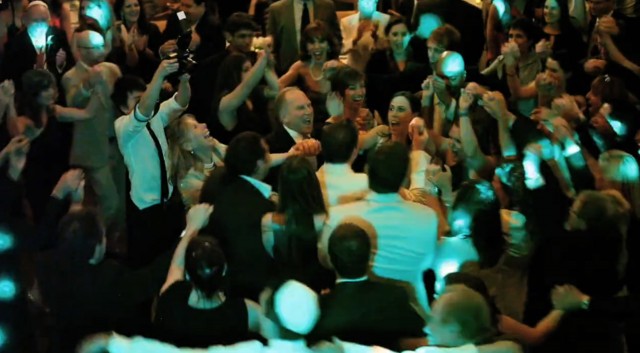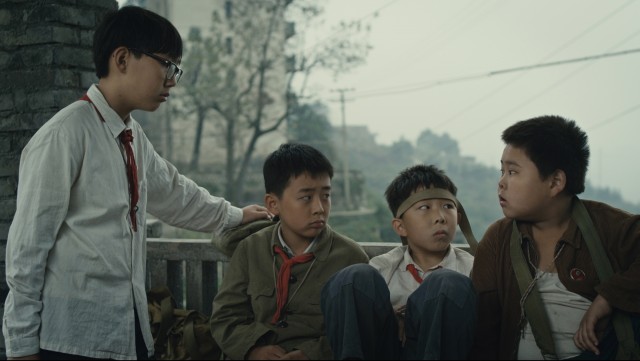
Four friends grow up during the end of the Cultural Revolution in Wang Xiaoshuai’s 11 FLOWERS
11 FLOWERS (Wang Xiaoshuai, 2011)
Quad Cinema, 34 West 13th St., 212-255-2243
Film Society of Lincoln Center, Elinor Bunin Munroe Film Center
Francesca Beale Theater, 144 West 65th St. between Broadway & Amsterdam Ave., 212-875-5601
Opens Friday, February 22
firstrunfeatures.com/11flowers
 Sixth Generation Chinese director Wang Xiaoshuai (Beijing Bicycle, Shanghai Dreams) reaches back into his childhood in the poignant, autobiographical 11 Flowers. Set in 1975 near the end of Mao’s Cultural Revolution, the film is seen through the eyes of eleven-year-old Wang Han (Liu Wenquing), who lives with his family in a poor, remote village in Guizhou province as part of the Third Front movement, in which the nation moved industry inland to protect it from possible Soviet attack. Wang’s father (Wang Jingchun) spends the week away from his wife (Yan Ni), son, and young daughter (Zhao Shiqi), working at an opera house in town. When one of Wang’s teachers, Miss Zhou (Yu Yue), tells Wang that he should get a clean shirt so he can look good as the new class gym leader, his mother at first is mad at him for even asking for such a luxury item but ultimately makes him one. However, while fooling around with his friends, Louse (Zhang Kexuan), Mouse (Zhong Guo Liuxing), and Wei Jun (Lou Yihao), something happens to the shirt, which soon winds up in the hands of a possible murderer (Wang Ziyi) on the run from the police. Based on actual events that happened to him as a child, Wang’s 11 Flowers is a beautifully crafted coming-of-age film, reminiscent of Rob Reiner’s Stand by Me. Wang, who was known as Wang Han when he was a boy, narrates the opening and closing himself, adding yet more personal touches to the tale. Hovering over the work is the specter of the Cultural Revolution; in one moving scene, adults have gathered for a small dinner party, but when one of them starts singing an old favorite tune, Wang’s father quickly changes it to a Mao-endorsed propaganda song for fear of being caught doing something against the government’s wishes. Much like Wang’s father teaches his son how to paint, interpreting reality on canvas, director Wang interprets his childhood reality onscreen in this small gem of a film.
Sixth Generation Chinese director Wang Xiaoshuai (Beijing Bicycle, Shanghai Dreams) reaches back into his childhood in the poignant, autobiographical 11 Flowers. Set in 1975 near the end of Mao’s Cultural Revolution, the film is seen through the eyes of eleven-year-old Wang Han (Liu Wenquing), who lives with his family in a poor, remote village in Guizhou province as part of the Third Front movement, in which the nation moved industry inland to protect it from possible Soviet attack. Wang’s father (Wang Jingchun) spends the week away from his wife (Yan Ni), son, and young daughter (Zhao Shiqi), working at an opera house in town. When one of Wang’s teachers, Miss Zhou (Yu Yue), tells Wang that he should get a clean shirt so he can look good as the new class gym leader, his mother at first is mad at him for even asking for such a luxury item but ultimately makes him one. However, while fooling around with his friends, Louse (Zhang Kexuan), Mouse (Zhong Guo Liuxing), and Wei Jun (Lou Yihao), something happens to the shirt, which soon winds up in the hands of a possible murderer (Wang Ziyi) on the run from the police. Based on actual events that happened to him as a child, Wang’s 11 Flowers is a beautifully crafted coming-of-age film, reminiscent of Rob Reiner’s Stand by Me. Wang, who was known as Wang Han when he was a boy, narrates the opening and closing himself, adding yet more personal touches to the tale. Hovering over the work is the specter of the Cultural Revolution; in one moving scene, adults have gathered for a small dinner party, but when one of them starts singing an old favorite tune, Wang’s father quickly changes it to a Mao-endorsed propaganda song for fear of being caught doing something against the government’s wishes. Much like Wang’s father teaches his son how to paint, interpreting reality on canvas, director Wang interprets his childhood reality onscreen in this small gem of a film.
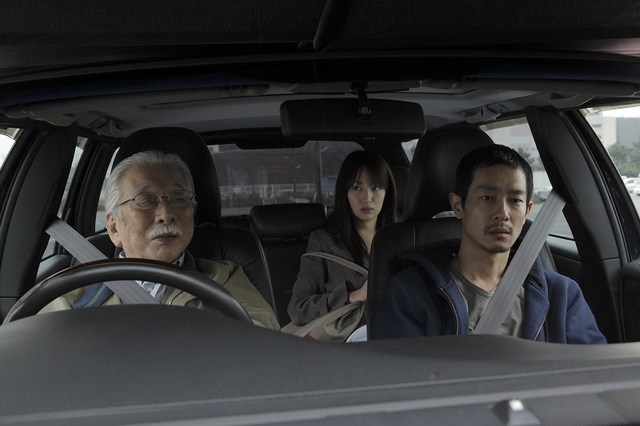
 Following the Tuscany-set
Following the Tuscany-set 
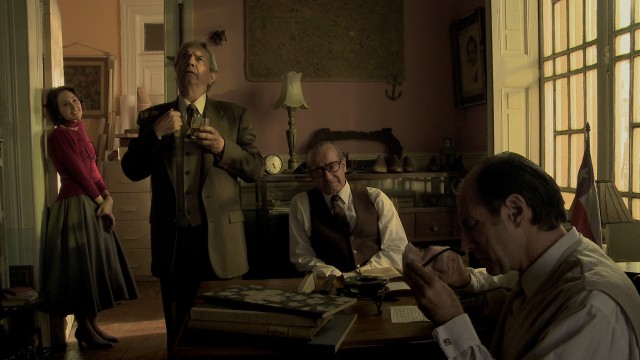
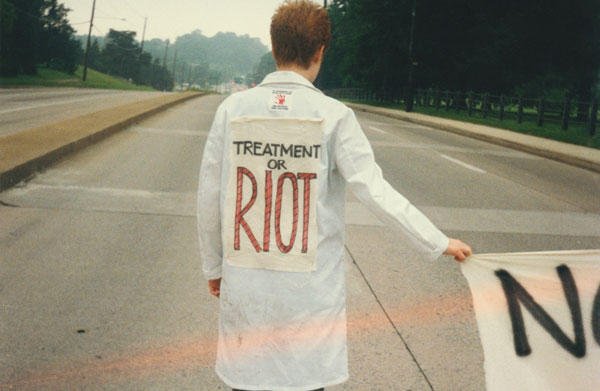

 Kirby Dick’s The Invisible War is one of the bravest, most explosive investigative documentaries you’re ever likely to see. Dick (This Film Is Not Yet Rated) busts open the military’s dirty little secret, revealing that episodes of horrific sexual abuse such as the Tailhook scandal are not an aberration but a prime example of a rape epidemic that seems to an accepted part of military culture. Dick speaks with many women and one man who share their incredible stories, describing in often graphic detail the sexual abuse they suffered, then faced further abuse when they reported what had happened. Their superiors, some of whom were the rapists themselves, either looked the other way, laughed off their allegations as no big deal, or threatened the victims’ careers. Dick includes remarkable Defense Department statistics — the government admits that approximately one out of every five female soldiers suffers sexual abuse and that there were nineteen thousand violent sex crimes in 2010 alone — even as such military officials as Dr. Kaye Whitley, Rear Admiral Anthony Kurta, and Brigadier General Mary Kay Hertog make absurd claims that they are satisfied with the way they are handling the alarming trend. The central figure in the film is Kori Cioca, a former member of the Coast Guard whose face was broken when she was raped by a superior and now keeps getting denied necessary medical services from the VA. Such courageous women as USAF Airman 1st Class Jessica Hinves, former Marine Officer Ariana Klay, USN veteran Trina McDonald, USMC Lieutenant Elle Helmer, USN Lieutenant Paula Coughlin, and even Special Agent Myla Haider of the Army Criminal Investigation Command also open up about the physical and psychological damage the abuse has left on their lives and careers. Inspired by Helen Benedict’s 2007 Salon.com article “The Private War of Women Soldiers,” Dick and producer Amy Ziering (The Memory Thief) have presented a searing indictment of an endemic military culture that has to come to an end, and fast. The Invisible War, which earned Dick and Ziering last year’s Nestor Almendros Award for courage in filmmaking at the Human Rights Watch Film Festival at Lincoln Center, is back at the Elinor Bunin Munroe Film Center for a brief run through January 24, celebrating its Oscar nomination for Best Documentary Feature.
Kirby Dick’s The Invisible War is one of the bravest, most explosive investigative documentaries you’re ever likely to see. Dick (This Film Is Not Yet Rated) busts open the military’s dirty little secret, revealing that episodes of horrific sexual abuse such as the Tailhook scandal are not an aberration but a prime example of a rape epidemic that seems to an accepted part of military culture. Dick speaks with many women and one man who share their incredible stories, describing in often graphic detail the sexual abuse they suffered, then faced further abuse when they reported what had happened. Their superiors, some of whom were the rapists themselves, either looked the other way, laughed off their allegations as no big deal, or threatened the victims’ careers. Dick includes remarkable Defense Department statistics — the government admits that approximately one out of every five female soldiers suffers sexual abuse and that there were nineteen thousand violent sex crimes in 2010 alone — even as such military officials as Dr. Kaye Whitley, Rear Admiral Anthony Kurta, and Brigadier General Mary Kay Hertog make absurd claims that they are satisfied with the way they are handling the alarming trend. The central figure in the film is Kori Cioca, a former member of the Coast Guard whose face was broken when she was raped by a superior and now keeps getting denied necessary medical services from the VA. Such courageous women as USAF Airman 1st Class Jessica Hinves, former Marine Officer Ariana Klay, USN veteran Trina McDonald, USMC Lieutenant Elle Helmer, USN Lieutenant Paula Coughlin, and even Special Agent Myla Haider of the Army Criminal Investigation Command also open up about the physical and psychological damage the abuse has left on their lives and careers. Inspired by Helen Benedict’s 2007 Salon.com article “The Private War of Women Soldiers,” Dick and producer Amy Ziering (The Memory Thief) have presented a searing indictment of an endemic military culture that has to come to an end, and fast. The Invisible War, which earned Dick and Ziering last year’s Nestor Almendros Award for courage in filmmaking at the Human Rights Watch Film Festival at Lincoln Center, is back at the Elinor Bunin Munroe Film Center for a brief run through January 24, celebrating its Oscar nomination for Best Documentary Feature.